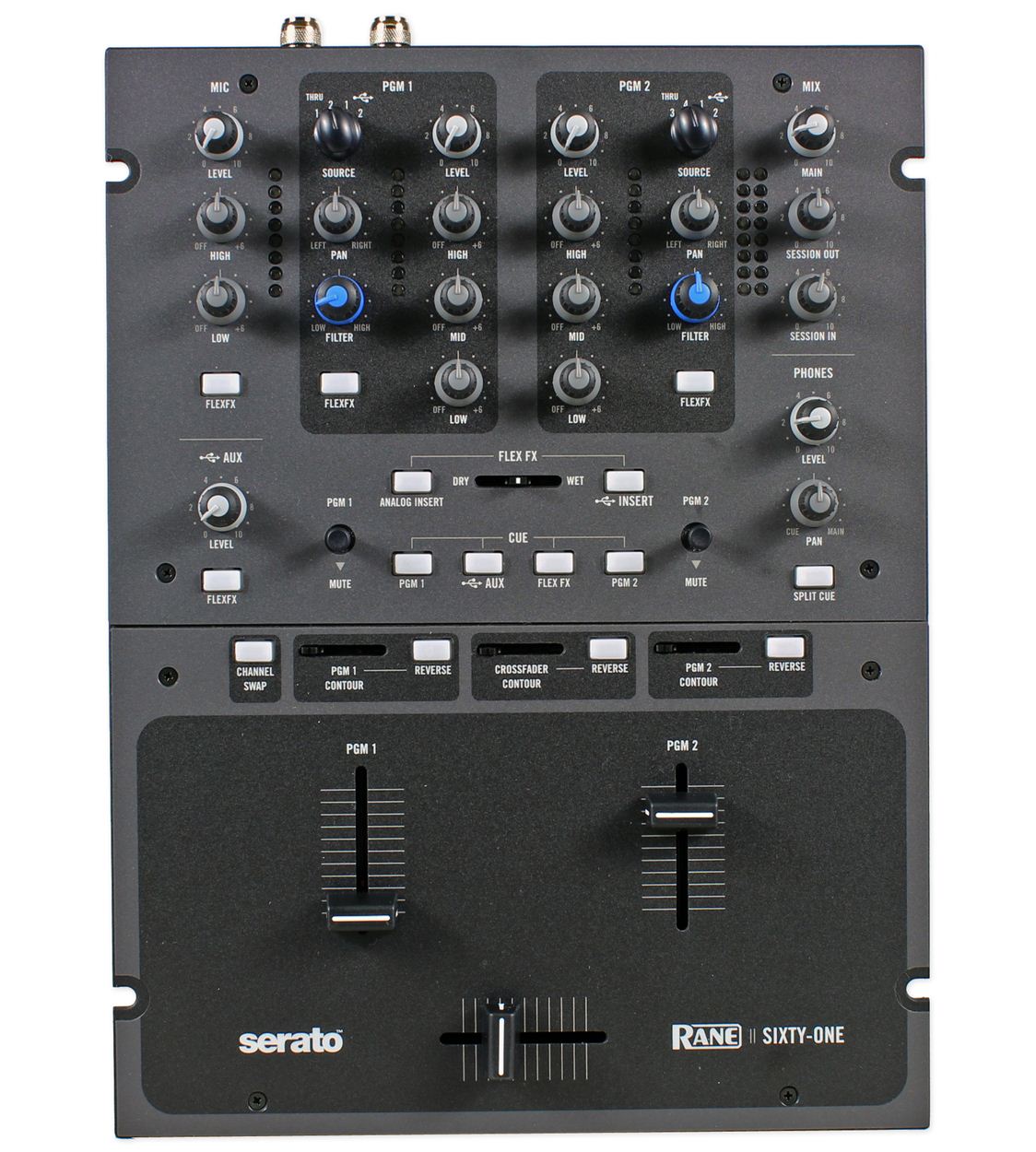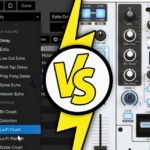Video Review
Serato Scratch Live (“SSL”) software has immense influence in the digital vinyl (or “DVS”) world. Digital vinyl systems use traditional DJ gear (record decks/CDJs and mixers) to control laptop software and thus digital music files. While nowadays SSL has a strong competitor in Traktor Scratch, it continues to wield a lot of power and respect – and by extension, so does Rane, Serato’s close hardware partner for Scratch Live.
As well as producing audio interfaces that allow you to use your traditional DJ mixer with Serato Scratch Live, Rane also produces digital DJ mixers that do away for the need for an audio interface. Plug two turntables into a Serato Scratch Live-enabled DJ mixer, such as the Rane Sixty-One reviewed here today, and you need no extra hardware apart from your laptop to be able to DJ using software and digital music files. Let’s take a closer look…
First impressions and setting up
Rane doesn’t produce shoddy gear, and it doesn’t produce cheap gear, either; on unboxing (and checking the price – a cool US$1,400) it is clear that the Rane Sixty-One continues the tradition. It’s an understated mixer, appearing at very first glance like any full-sized two-channel DJ mixer. It is metal, but not over-heavy, and painted in a sober grey and black colour scheme.
The only flash of colour is added by the two royal blue and black filter controls. As well as the mixer, the box contains two control records, two control CDs, a USB cable, an IEC C5 line power cord (or kettle lead, to us heathens), a quickstart guide, the full printed guide, and a software CD.
Back to the mixer itself. The front panel contains just the headphones sockets (1/4″ and 1/8″), and the whole unit sits on four screwed-in rubber feet. Round the back there are a big, chunky on/off switch and power socket, the USB for your laptop, TRS 1/4″ balanced outs (no XLRs), “session” ins and outs (more on these later), the effects loop ins/outs (again, paired TRS, this time unbalanced). four RCA inputs (switchable from phono to CD), a mic input (again, switchable mic/line) and a pair of earthing poles with oversized screw-downs for the deck grounding.

To the top of the mixer. There is a lip around the top edge, and four bolt holes to allow the unit to be fitted into a permanent DJ set-up, flush with the surface. The top plate is in two halves, the bottom half covering the faders, the top half all the other controls.
The faders are magnetic and nicely loose in feel; the magnetic design means that even if they get dirty and feel a bit dodgy (stuff does get spilt on mixers, after all), they’ll be more likely to continue to perform well.
The three controls above the two line faders give away the scratch DJ pedigree of this mixer; all are squarely aimed at turntablists. Thus you get a channel swap button, plus fader contour and reverse buttons for all three faders.
The faders hit full reach before they contact the top plate, stopping with a pleasing, slightly damped feel that means I doubt anyone is going to use this mixer carefully keeping the lines at 2/3rds; it screams to have fine tuning done at the trims and have the lines used throughout their reach. That’s how I fell into using it, anyway.
The upper half of the top panel contains all the other controls. The mixer’s two channels (each of which has gain and three-band EQ) have input selectors for the analogue and digital inputs (more later), including the requisite thru/USB settings. There are FX send buttons for both of these main channels, as well as for the microphone channel (two EQs and a gain) and the AUX (which is a digital AUX designed primarily to carry the signal from the sample decks).
True analogue “aux” thru is provided by the session input, which has a volume in (but no other controls on the input) and a “session out” level. Rane says this is typically used for hooking multiple mixers together, but I can see it used more like a true “emergency thru” (session in) and as a booth monitor (session out), as the output is effectively a second master out, with its own volume control.
Finally, there are the cue buttons (including an FX cue), the dry/wet mini-fader for the FX send, and two insert buttons for the effects (more later on this). Oh, and two small “mute” joysticks: These are the modern-day equivalent of the sprung toggles we used to use back in the day as cut switches; move these in any direction from central and they have the same effect, killing the channel until released, upon which they spring back to central and the channel’s throughput is restored.
In use
Rane and Serato’s system is like the Apple of the DVS world; it’s meant to just work, and by and large, it does. You install Serato Scratch Live (it’ll automatically install the correct drivers, Core Audio or ASIO depending upon whether you’re on Mac or PC, as long as you follow the instructions and have the hardware plugged in as you run the installers); calibrate your decks (it’s simple – one-button, basically); and plug everything in as they say. Then, it all just works. Took me all of 10 minutes.

The mixer is described by Rane as “dual personality”, and that fits well, as it is equally at home with analogue and digital sources, switching seamlessly between the two. That means you can use it in situations where you have a vinyl/CD and digital vinyl DJs playing, or indeed where you want to mix and match within the same set.
The unit screams usability: the aforementioned smooth faders; hard, backlit, minimal-movement pushbuttons; and low-resistance panel-bolted pots all meaning it inspires supreme confidence in use. The filters are actually hardware effects and sound customarily excellent.
The “Flex FX” is also a hardware/software hybrid; you can use the analogue insert button to send any source that has the “Flex FX” button pressed (including multiple sources) to the FX bus, so you can add external hardware effects (such as Pioneer’s new RMX-1000, for instance), but also you can send your chosen sources (and that includes analogue sources) through Serato Scratch Live’s DJ FX by pressing the USB insert button. Interestingly, you can also do both, and a schematic in the manual shows you how this all fits together.
Serato Scratch Live’s effects can themselves be daisy-chained into two sets of three, so overall you have quite some flexibility available here. However, the eagle-eyed among you will have spotted that there are no controls at all on the mixer for effects other than the on/off and wet/dry controls, and the hardware filters. We’ll mull over this omission in the conclusion.
Rane makes much of the audio interface spec in this unit (32-bit floating point, 48kHz), and on test through half-decent studio monitors it sounded truly excellent: smooth, with clarity, warmth, punchy bass and crisp, pleasing highs.
I wired up an iPhone (via its headphones socket) through the Session In channel on the Rane to test the emergency thru capability of the unit, and the iPhone sounded shockingly bad against the lovely digital audio from the built-in interface on the Rane.
It’s also worth noting here that the interface can (unlike the mixer’s SSL predecessor, the TTM-57SL) be used as a six-stereo-record, four-stereo-playback audio interface for any software when Serato Scratch Live isn’t running, thanks to a supplied control panel app.
Regarding the interfacing with Serato Scratch Live software, I felt instantly at home mixing “vinyl” on it, and as a DJ who played on vinyl for 15 years before “going digital” (and by “going digital” I mean all-out, switching to controllers, not DVS), it felt completely authentic. As I alluded to at the start of this section overall it “just worked” – exactly as expected, with no real surprises.
Conclusion
Very quickly you start to mull over what Serato intends this mixer to be used for. You see, the TTM-57SL, as Serato’s previous only two-line Serato Scratch Live mixer, was trying to be everything to everyone, with effects, loops and so on onboard. This mixer has none of that. Conversely, the Sixty-Two – released at the same time – is all bells and whistles. It’s like the company is trying to replace the ’57 with not one, but two mixers.

Here’s what I think their reasoning is. The Sixty-One, for me, is designed for hardcore vinyl enthusiasts, who want to incorporate digital vinyl into their DJing. When Serato Scratch Live is in “absolute” mode, it is designed to really, truly, emulate real vinyl. The start of the control record is the start of the MP3; the end of the record, the end of the MP3. Jog the turntable, the MP3 “jogs”.
Necessarily, therefore, there will be no looping, cue points and so on DJing like this – because it’s not present on vinyl. For Djing in this manner, the Sixty-One has exactly what you need – and nothing more. (While the whole surface is Midi mappable, I don’t think many users are likely to take advantage of this.)
The filter is a nod to the present, granted, and of course you can switch into relative mode and start introducing some of the bells and whistles of digital DJing, but don’t expect the Sixty-One to come along for the ride: You’ll be using your laptop to control the effects, loops and cues, (or alternatively, you’ll go for an external Midi controller). The Rane Sixty-One could in this light be seen as a TTM-56S, but with Serato Scratch Live capability.
The Sixty-Two, however, has built-in effects, cues, loop controls and so on – it’s more like the ’57, but with the advances that both of these mixers share over that mixer (better audio interface with the ability to use it with other applications, USB 2.0, plus easy switching between analogue and digital, or indeed two laptops in the case of the Sixty-Two),
Between the two models, I believe Rane wants to cover two distinct customer types, and I wouldn’t be surprised therefore to see the ’57 phased out. (Update: the TTM 57SL has indeed been discontinued.)
Which only leaves us with the price, and here’s where things start to look less rosy. The Sixty-One is priced pretty much the same as the ’57, and features-wise, you’re getting less. Higher spec maybe, but less overall. You’re frankly paying a hefty premium. (If you were comparing the ’57 to the Sixty-Two, in many ways its more natural replacement out of the two, well, the difference is a cool US$600.) You definitely need to consider whether it is worth the extra over the ’57 for you.
To conclude. The Rane Sixty-One provides a simple, elegant, pristine quality “in” into turntablism, and is particularly suited to the technology-agnostic DJ (probably turntablist) who simply wants hardcore vinyl emulation without any complications. It’s Apple-like in its implementation of digital vinyl; Rane and Serato have made switching between real vinyl and control vinyl use a cinch, and have set a new benchmark for usability here.
It sounds amazing, and the flexibility afforded by its sound interface makes all kinds of hardware/software permutations possible and indeed straightforward. But if you want the bells and whistles you may be expecting from a new Rane mixer having got used to the spec of the ’57, you need to look to the Sixty-Two – and swallow a significant price jump to boot.
Are you a vinyl DJ who’s been waiting for this type of set-up to make the leap to digital? Do you think this is priced about right, or is under-featured for the money? Do you prefer timecode-enabled mixers to separate timecode audio interfaces? Please let us know your thoughts in the comments.








